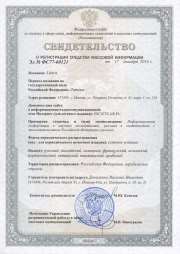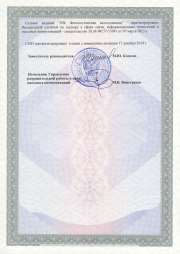|
MAIN PAGE
> Back to contents
Litera
Reference:
Pavlova A.D., Guruleva T.L.
Peculiarities of genesis of the classical phrase particles of Chinese language
// Litera.
2021. № 1.
P. 134-143.
DOI: 10.25136/2409-8698.2021.1.34877 URL: https://en.nbpublish.com/library_read_article.php?id=34877
Peculiarities of genesis of the classical phrase particles of Chinese language
Pavlova Alena Dmitrievna
PhD in Philology
External Doctoral Candidate, the department of Far Eastern Languages, Military University of the Ministry of Defense of the Russian Federation, Senior Lecturer, Financial University under the Government of the Russian Federation
115547, Moscow, Mihnevskiy proezd, 4-89

|
ahisha@mail.ru
|
|
 |
|
Guruleva Tatiana Leonidovna
Doctor of Pedagogy
Professor, the department of Far Eastern Languages, Military University of the Ministry of Defense of the Russian Federation
125047, Russia, g. Moscow, ul. Volochaevskaya Ulitsa, 1

|
gurulevatatiana@mail.ru
|
|
 |
|
DOI: 10.25136/2409-8698.2021.1.34877
Received:
17-01-2021
Published:
27-01-2021
Abstract:
This article is dedicated to the evolution of phrase particles in Chinese language. The goal consists in examination of genesis of the classical phrase particles of Chinese language and their development patterns. The article also describes the origins of phrase particles, which were established as a result of analysis of the genesis. The relevance of this research is substantiated by the need for diachronic analysis of the particles in order to understand the essence and peculiarities of the functionality of modern particles. Recent years indicate heightened interest to learning Chinese language. The requirements to the level of formation of the Chinese linguistic personality in the process of teaching Chinese language at schools and universities have also grown significantly. Phrase particles play an important role in the development of communicative competence of the learners of Chinese language. Leaning on the existing theoretical works and written sources, the author analyzes the particles of Putonghua from the III century BC until the eary XX century was performed, as well as reconstructs the process of formation and development of the modern classical phrase particles (啊,吗,吧,呢,了,的). The conclusions are formulated on the origins of classical phrase particles of Chinese language and their development patterns; description is given to the peculiarities of formation of each of the classical phrase particles.
Keywords:
sentence-final particle, modal particles, translation, discoursec particles, Chinese, particle etymology, modality, grammaticalization, function words, lexicalization
This article written in Russian. You can find original text of the article here
.
Фразовые частицы китайского языка, называемые также в зависимости от лингвистической традиции модальными частицами («语气词»), «discourse/pragmatic particle» («дискурсивнаяпрагматическая частица») или «sentence-final particle» (букв. «частица в конце предложения»), являются самостоятельной частью речи в китайском языке, относятся к служебным словам[22],[23]. Они занимают позицию в конце предложения или фразового единства, не имеют денотативного значения в синхронии, могут передавать добавочные смысловые значения и экспрессивные оттенки, меняют модальность или стилистическую окраску высказывания и выражают отношение говорящего к содержанию высказывания [14]. Данное определение сделано на материале путунхуа и не включает особенности употребления фразовых частиц в диалектах, а также не учитывает диахронические изменения китайского языка.
Чтобы досконально разобраться в сущности современных фразовых частиц китайского языка нам необходимо понимать, как они сформировались. Как указывает Т.М. Николаева, диахронический анализ показывает наличие своего значения у любой частицы, которое можно сформулировать в общем виде. И оно, общее значение, «пронизывает всю систему употребления слова с частицей, создавая сложную систему смысловых переходов – постепенных, с градуально меняющейся семантикой» [4, с.23].
Актуальность исследований генезиса фразовых частиц китайского языка обусловливается также и постоянным повышением интереса к изучению китайского языка [5],[4], необходимостью учета особенностей китайской языковой личности в процессе обучения китайскому языку в школе и вузе [1]. Как отмечает исследователь частиц славянских языков Т.М.Николаева [4, с.10]: «Употребление частиц нужно не усвоить, а освоить. Кроме того, очевидно, что для ряда типологически различных языков необходим перевод, кардинально отличный по структуре». Для того, чтобы уметь переводить предложения с использованием фразовых частиц, необходимо сначала понять принципы функционирования фразовых частиц в языке и их роль в предложении. О важной роли частиц в коммуникации говорит А.Вежбицкая: «Если человек, учащий какой-либо язык, не сможет овладеть значениями его частиц, коммуникативная компетенция такого человека будет трагически неполной»[6, с.327]. Выполненный нами анализ генезиса фразовых частиц китайского языка (путунхуа) на основе имеющихся теоретических работ, письменных источников с III в. до н.э. до начала XX в.. позволил выявить источники происхождения и закономерности развития фразовых частиц, выявить причины функциональной диверсификации современных фразовых частиц.
Исследование генезиса фразовых частиц китайского языка началось в середине XX века. Первые исследования генезиса функций фразовых частиц были приведены в работе учёного Люй Шусяна [3], где была предпринята попытка дать объяснение происхождения современных учёному фразовых частиц на основе анализа грамматик разных исторических периодов. Одной из первых работ, посвященных именно проблеме генезиса фразовых частиц, и по сей день единственной, которая описывает весь эволюционный процесс от первых упоминаний фразовых частиц до начала XX века, является исследование Сунь Сисиня «Фразовые частицы китайского языка периода нового времени: исследование истории фразовых частиц китайского языка» [8]. Эта работа положила начало новому направлению в исследовании фразовых частиц – генезис фразовых частиц. Исследование является первой самостоятельной работой в этом направлении, построенном на сквозном исследовании процесса эволюции фразовых частиц каждого из исторического периода развития китайского языка. В конце XX века - начале XXI века появляются работы, погружающиеся в детальные и глубокие исследования отдельно взятых периодов. Например, Чжан Юйцзинь в работе «К вопросу о том, являются ли гадательные надписи “抑” и “执” фразовыми частицами» исследует первые возможные частицы, которые могли использоваться уже в период 甲骨文 (цзягувэнь, гадательные надписи на костях и черепашьих панцирях XIV - XI вв. до н. э.) [10]. Период развития фразовых частиц до начала III века до н.э. исследует на материале существующих письменных источников Чжан Чжэньлинь в работе «Фразовые частиц в доциньских источниках» [9]. Исследование Ли Сяоцзюня «Происхождение и развитие фразовых частиц от доциньского периода до периода эпохи Тан и Пяти династий» построено на исследовании классических произведений обозначенных периодов, в основном, это III век до н.э. – X век н.э.[7]. В своей работе Ли Сяоцзюнь не только описывает найденные частицы, но и делает попытку вывести закономерности развития систем фразовых частиц до начала формирования современных классических фразовых частиц китайского языка. Примечательна также работа Чжай Янь «Исследование фразовых частиц северной группы диалекта гуаньхуа периода династии Цин», в которой исследование затрагивает один период, но использованы произведения из разных регионов одного периода [11]. В работе отражены различия в использовании фразовых частиц внутри одной диалектной группы. Исследования служебных слов на материале переводов буддийских текстов, например, Лун Гофу «Исследование служебных слов в переводах сутр Яо Циня», позволяют оценить влияние, которое оказали другие языки на формирование фразовых частиц китайского языка[12].
В данной статье отражены результаты анализа статистических данных исследований проведенных по историческим периодам от III века до н.э. до начала XX века. Опираясь на результаты теоретических трудов, статистические данные об использовании фразовых частиц в художественных произведениях разных исторических периодов мы смогли реконструировать процесс формирования классических фразовых частиц современного китайского языка.
Система фразовых частиц отличается в каждом из исторических периодов. На основании изменений, происходящих с частицами, можно выделить следующие исторические периоды развития фразовых частиц: «春秋战国» («период Чуньцю (770-476/403 гг. до н.э.) и Сражающихся царств (476/403-221 гг. до н.э.)»), «两汉» («обе династии Хань (ранняя 206 г. до н.э. ― 8 г. н.э.; поздняя 25 г. ― 220 г. н.э.)», «魏晋南北朝» (эпохи Вэй, Цзинь, Южных и Северных династий (общий термин для исторического периода 220-589 гг.)), «唐五代» (династия Тан (618—906 гг.) и эпоха Пяти династий (907—960 гг.), «宋元» (династия Сун (960―1279 гг.) и династия Юань (1280-1367 гг.), 明清 (династии Мин (1368-1644) и Цин (1644-1911)), XX век [17].
Становление современных классических фразовых частиц китайского языка (啊,吗,呢,了,的,吧) – сложный и длительный эволюционный процесс, состоящий из разных этапов. Говоря об источниках, от которых берут своё начало новые фразовые частицы, мы выделили следующие способы образования новых частиц:
1. грамматикализация других частей речи
2. лексикализация словосочетаний
3. фонетико-функциональные изменения
4. заимствования
1. Грамматикализация других частей речи
Переход в другие части речи посредством грамматикализации в отношении фразовых частиц имеет такие особенности в китайском языке:
1) при грамматикализации знаменательных или служебных частей речи происходит переход от семантически-синтаксических функций слова к прагматической функции частицы;
2) постепенное изменение синтаксического положения в предложении – одно из главных условий начала процесса грамматикализации, т.н. ослабление синтаксической позиции;
3) происходит переход от семантически значимого слова к слову, которое относится ко всему предложению и имеет прагматическое значение.
Для фразовых частиц, появившихся до периода Тан (618 — 907 гг.), можно выделить следующие примеры происхождения фризовых частиц путем грамматикализации знаменательных или служебных частей речи:
1. Грамматикализация указательного местоимения (частицы 者,焉,尔)
2. Грамматикализация глагола(частицы 已,云,为,在,来)
3. Грамматикализация существительного(частицы 时,後,里)
4. Грамматикализация отрицательного наречия(частицы 不,无)
5. Грамматикализация наречий(частица 好)
6. Грамматикализация других служебных слов(частицы 着, 来,来着,了)
Проведенный нами анализ показывает, что современные фразовые частицы, в основном, начинают формироваться к концу периода династии Тан. Например, частицы 了,吗,吧,啊,呢. Частица 的 начинает формироваться в период династий Сун – Юань (X – XIVвв.) [20].
Прежде, чем стать современными фразовыми частицами, они прошли длинный путь из различных трансформаций, но начало для них или для тех частиц, что положили начало этим частицам, было в грамматикализации разных частей речи:
Частица 啊:грамматикализация существительного 後, наречия 好;
Частица 吗:грамматикализация отрицательного наречия 无, 不 в составе вопросительной структуры;
Частица了:грамматикализация глагола или служебного слова 了 («завершать»)[13];
Частица 呢:грамматикализация существительного 里, других служебных слов, лексикализация сочетания在裏, функциональная ассимиляция с другими частицами;
Частица 吧:грамматикализация глаголов 休、罢 («прекратить»);
Частица 的:грамматикализация служебного слова 底(служебное слово 地).
2. Лексикализация словосочетаний (для двусложных частиц)
Лексикализация комбинации двух разных грамматических единиц, стоящих рядом, но не имеющих между собой смысловой связи – это один из источников появления двусложных фразовых частиц китайского языка. Вслед за семантической грамматикализацией и, в то же время, усилением субъективации, обе части переходят в одну грамматическую категорию (часть речи становится одна), и такая комбинация получает отличные грамматические, семантические и прагматические функции. Рассмотрим на примере формирования фразовой частицы 而已, которая встречается и в современном китайском языке.
В период династии Хань (ранняя и поздняя Хань – III в. до н.э. – III в.н.э.) существовали одновременно частица 已 и глагол 已 («иссякнуть, завершить»). А также сочетание глагола 已 с союзом 而 (сочинительный союз). Из-за ослабления глагола, союз также начал терять значение. Получилась схема перехода: союз+глагол — союз+частица— двусложная частица. Лексикализация привела к ослаблению значений глагола已 и союза 而 (семантическое ослабление), что повлияло на снижение их информационной ценности в предложении. Сочетание начало восприниматься слушающими и говорящими как грамматическая категория, что привело к переходу их в единую грамматическую единицу и появлению фразовой частицы. Этому способствовало три условия: первое, с точки зрения семантики постепенно ослабло значение глагола 已,союза而; второе, синтаксически, грамматикализация глагола已 привела к тому, что функция 而 как союза ослабла, так как фразовые частицы в китайском стоят в конце высказывания и им не требуются союзы для связи с предложением; третье, высокая частота использования в письменной речи. В большей части примеров периода Цинь-Хань (III в. до н.э. – III в.н.э.) сочетание 而已 уже является двусложной фразовой частицей и используется в значении модальности ограничения [7].
3. Фонетико-функциональные изменения
Фонетико-функциональные изменения – в процессе развития и использования с частицей происходят фонетические изменение, приводящие к формированию новой частицы (функционально самостоятельной). Это могут быть редукция, стяжение (комбинирование звуков), сандхи, разделение (диссимиляция) звуков, ассимиляция звуков.
Фонетико-функциональные изменения, как правило, происходят с уже сформировавшейся фразовой частицей, но в результате фонетических изменений появляется новая частица с новыми функциями, которые могут быть шире или уже первоначальной частицы. Также немаловажным фактором в фонетико-функциональных изменениях является иероглифическая стандартизация написания, или изменение иероглифического написания частицы.
Как показывает результат исследования генезиса классических фразовых частиц, фонетические изменения приводят к функциональным изменениям, поэтому мы называем такие изменения фонетико-функциональными.
Все современные классические фразовые частицы путунхуа подверглись в своём развитии фонетико-функциональным изменениям. Наибольшее влияние этот процесс оказал на появление частиц 啊,呢,吗.
Частица 啊(a) современного китайского языка является результатом редукции другой частицы 呵(ha)в период династии Мин (1368—1644 гг.) [19]. А частица 呵 является результатом фонетико-функциональной ассимиляции частиц 後,呵,好 в период династии Юань-начале династии Мин (XIII - XIV вв.).
Частица呢 (ne) имеет самое сложное происхождение из всех классических фразовых частиц. Современная частица 呢 является фонетико-функциональной ассимиляцией частиц 哩 (li) и 呢 (ne), которая окончательно завершилась в конце XIX - начале XX века. Частица 哩 по-прежнему встречается в диалектах. Иероглифически частица 呢 фиксируется с периода династии Юань (1280-1367 гг.) и в то время является синонимом частиц 哩,那 (na) [18]. В период династии Мин (1368-1644 гг.) происходит функциональное разделение этих частиц: частица 哩 чаще используется в повествовательных и восклицательных предложениях, частица 呢 чаще используется в вопросительных, а частица 那 только в утвердительных предложениях и является диалектных вариантом [15]. Однако в период династии Цин (1644 -1911 гг.) частица 那 начинает записываться как 哪 и сливается с частицами 哩, 呢, «передав» им свои функции. Это приводит к концу периода династии Цин к функциональному разделению частиц 哩, 呢. Частица 哩 используется, в основном, в невопросительных предложениях, а частица 呢- в вопросительных и невопросительных. И хотя обе эти частицы одинаково распространены по частотности, в конце XIX - начале XX века частица 呢 используется вместо частицы哩 в пекинском диалекте (столичном), и это становится триггером для её повсеместного распространения и замены частицы 哩.
В свою очередь частицы 哩, 呢 периода династии Юань являются иероглифическим изменениемстандартизацией (скорее всего вызванным фонетической ассимиляцией) частиц 尔 и 聻(尼)в случае частицы 呢 в период династии Сун (X-XIII вв.), и результатом грамматикализации существительного 裏(里) или сочетания 在裏 в случае частицы 哩.
Современная частица 吗 (ma) окончательно оформилась в конце периода династии Цин. Свои истоки она берет от структуры вопроса с отрицательным наречием в конце ( 不,否,未, 无 (VP无)) типа A-отрицание-A в период династии Тан [16]. В период Пяти династий – начало периода династии Сун (X-XI вв.) происходит иероглифическая стандартизация в виде иероглифа麼. Однако уже в последующий период династии Юань (1280-1367 гг.) отмечается фонетическая диссимиляция (у иероглифа 麼 два чтения muo и ma) и попытка стандартизировать путем ввода иероглифа末 для стандартизации чтения в виде «ma». И это удается сделать в период династии Мин (1368-1644 гг.), где, в основном, употребляется одна частица 麼. Но в начале периода Цин (1644 -1911 гг.) фиксируется функциональная диссимиляция, которую связывают с появлением диалектного варианта записи в виде иероглифа 吗 (использовалась только в вопросительных предложениях), хотя частица 麼 имеет более широкое распространение и используется во всех типах предложений. К концу периода династии Цин эти тенденции закрепляются. В утвердительных предложениях и в середине предложения используется частица 嘛 (иероглифическое изменение частицы 麼), в вопросительных предложениях используется частица 吗.
4. Заимствования
В истории развития китайского языка отмечено несколько периодов, когда иностранные языки оказали влияние на китайский язык. Например, перевод буддийских текстов начиная с периода династии Хань (II в. до н. э. — III в. н. э.), контакты с северными народами в период Южных и Северных династий (420-589 гг.), влияние монгольского и маньчжурского языков, некоторое влияние европейских языков в конце династии Цин. Однако по мнению ряда исследователей на фразовые частицы эти интервенции оказали незначительное влияние [21],[7],[24]. Напрямую влияние эти языковые интервенции не оказали, но стали стимулирующим воздействием на систему фразовых частиц каждого из периодов. Например, перевод буддийских текстов поспособствовал появлению большего количества текстов в разговорном стиле, и, следовательно, развитию функций существовавших фразовых частиц, замене фразовых частиц вэньяня их функциональными аналогами на байхуа. Что касается монгольского влияния, то оно, например, отмечается в развитии функций частицы 呵, которая изначально имела функцию маркировки паузы в середине предложения, и при переводе с монгольского на китайский часто ставилась в предложениях после сослагательного деепричастия. Со временем предложения условия стали ассоциироваться с частицей 呵, а в дальнейшем частица 呵 была заменена уже имевшими такое же значение частицами 时,後.[7, c.283]
Значительно большее влияние оказал на диалекты нормативный китайский язык. Особенно ярко мы замечаем это в конце периода династии Цин, когда распространяется пекинский столичный вариант произношения со своими частицами, и тем самым привносит изменения в литературных язык других районов страны. Таким образом частицы 哪,呀,哇 изначально самостоятельные, вошли в состав и стали вариантами частицы 啊 [11]。
Таким образом можно сделать следующие выводы в отношении генезиса классических фразовых частиц китайского языка.
Все односложные классические фразовые частицы первоначально имели источник происхождения в виде грамматикализации знаменательных или служебных слов, либо в их состав вошли частицы, образованные этим способом.
Современные фразовые частицы не происходят напрямую от какой-либо части речи путем грамматикализации, все они прошли несколько этапов фонетико-функциональных изменений, в том числе иероглифических, а также подверглись влиянию пекинского варианта диалекта гуаньхуа.
Для фразовых частиц возможно вывести «общее значение» в диахронии, но в процессе эволюции некоторые современные классические фразовые частицы китайского языка (呢,啊) представляют собой комплекс функциональных значений вошедших в их состав других синонимичных частиц. Ряд других приобрели дополнительные значение, которые развились на основе «базового» значения (吧,了). Частица 吗 является отделившейся в самостоятельную частицу в результате фонетико-функциональных изменений от частицы 麽. Частица 的 является единственной современной фразовой частицей, которая берет своё начало в результате грамматикализации служебного слова.
Основной способ образования двусложных фразовых частиц – лексикализация сочетаний знаменательного и служебного слова или служебных слов.
Фразовые частицы не заимствуются из других языков, но языковые интервенции опосредованно влияют на систему фразовых частиц. Чаще встречаются внутриязыковые заимствования и замена схожих по функциям фразовых частиц диалектов на частицы, свойственные литературному языку или более распространенному (если говорить о письменной норме).
References
1. Guruleva T. L. Formirovanie lichnosti novoevraziiskogo tipa v sisteme vysshego yazykovogo vostokovedcheskogo obrazovaniya (na materiale kitaevedcheskogo obrazovaniya) // Avtoreferat dissertatsii doktora ped. nauk: 13.00.01. – Ulan-Ude, 2011. – 47 s.
2. Guruleva T. L. Vysshee yazykovoe obrazovanie v Rossii: vostochnyi vektor // Izvestiya Rossiiskogo gosudarstvennogo pedagogicheskogo universiteta im. A.I. Gertsena. – 2008 – № 71. – S. 252 – 261.
3. Lyui Shusyan Ocherk Grammatiki kitaiskogo yazyka T.2. – M., Izdatel'stvo «Nauka», 1965. – 349 s.
4. Nikolaeva T. M. Funktsii chastits v vyskazyvanii (na materiale slavyanskikh yazykov). M.: Izdatel'stvo «Nauka», 1985. – 170 s.
5. Reznik Yu. N., Guruleva T. L. Formirovanie mezhdunarodnogo polikul'turnogo obrazovatel'nogo regiona Sibiri, Dal'nego Vostoka Rossii i Severo-Vostochnykh provintsii Kitaya // Vestnik Chitinskogo gosudarstvennogo universiteta. – 2009. – №6. – S. 85-92
6. Wierzbicka, Anna Particles and linguistic relativity // International Review of Slavic Linguistics. – 1976. –Vyp.1.-№2/3. S. 327-367
7. 李小军, «先秦至唐五代语气词的衍生与演变», 北京 (Li Syaotszyun'. Proiskhozhdenie i razvitie frazovykh chastits ot dotsin'skogo perioda do perioda epokhi Tan i Pyati dinastii).Pekin, 2013. 341 s.
8. 孙锡信 , «近代汉语语气词»,北京 (Sun' Sisin', Frazovye chastitsy kitaiskogo yazyka perioda novogo vremeni: issledovanie istorii frazovykh chastits kitaiskogo yazyka). Pekin, 1999. 200 s.
9. 张振林, 《张振林学术文集》, 中山大学出版社 (Chzhan Chzhen'lin' Akademicheskii sbornik). Izdatel'stvo Universiteta Sun' Yatsena, 2019. 582 s.
10. 张玉金, «关于卜辞中“抑”和“执”是否句末语气词的问题》, 大连 (Chzhan' Yuitszin' «K voprosu o tom, yavlyayutsya li gadatel'nye nadpisi “抑” i “执” frazovymi chastitsami» ) // «Issledovaniya drevnekitaiskogo yazyka». Dalyan', 2000. №4. S. 30-35.
11. 翟燕, «清代北方话语气词研究», 山东大学出版社 (Chzhai Yan' «Issledovanie frazovykh chastits severnoi gruppy dialekta guan'khua perioda dinastii Tsin»). Izdatel'stvo Shan'dunskogo universiteta, 2013. 224 s.
12. 龙国富, «姚秦译经助词研究» , 湖南师范大学出版社, 长沙 (Lun Gofu «Issledovanie sluzhebnykh slov v perevodakh sutr Yao Tsinya»). Chansha, 2004. 323 s.
13. 曹广顺, «语气词“了”源流浅说», 语文研究 (Tsao Guanshun' «O proiskhozhdenii chastitsy “了” »)// «Lingvisticheskie issledovaniya». 1987. №2. S. 10 – 15.
14. 齐沪扬, «语气词与语气系统», 合肥:安徽教育出版社 (Tsi Khu''yan «Modal'nye chastits i sistema modal'nosti»). Khefei, 2002. 323s.
15. 俞光中, 植田均, «近代汉语语法硏究», 学林出版社 (Yui Guan'chzhun, Yueda Khitoshi «Issledovanie grammatiki kitaiskogo yazyka perioda novogo vremeni»). Izdatel'stvo Syuelin', 1999. 467 s.
16. 钟兆华, «论疑问语气词“吗”的形成与发展», 语文研究 (Chzhun Chzhaokhua «O formirovanii i razvitii voprositel'noi chastitsy “吗”»)// «Lingvisticheskie issledovaniya». 1997. №1. S.2 – 9.
17. 向熹, «简明汉语史(修订本)下», 商务印书馆 (Syan Si «Kratkaya istoriya kitaiskogo yazyka (ispravlennoe izdanie)»). Kommercheskoe izdatel'stvo, 2010. 839 s.
18. 黄斌, « “元曲选” 中的语气词“也、呵、那、阿、呀”», 古汉语研究 (Khuan Bin' «Chastitsy “也、呵、那、阿、呀” v“ Izbrannom sobranii dram mongol'skogo perioda”»)// «Issledovaniya drevnekitaiskogo yazyka». Dalyan', 1996. №1. S. 73 – 77.
19. 都兴宙, «近代汉语的“呵”与“後”», 青海师范大学学报:哲学社会科学版 (Dou Sinchzhou «“呵”i“後”vkitaiskom yazyke perioda novogo vremeni»)// «Zhurnal Tsinkhaiskogo pedagogicheskogo universiteta: izdanie filosofii i sotsial'nykh nauk», 1998. №1. S.101 – 104.
20. 太田辰夫, «中国语历史文法», 北京大学出版社 (Ota Tatsuo «Istoricheskaya grammatika kitaiskogo yazyka»). Izdatel'stvo Pekinskogo universiteta, 1987. 425 s.
21. 江蓝生, «疑问语气词“呢”的来源», 语文研究 (Tszyan Lan'shen «Istochniki proiskhozhdeniya voprositel'noi chastitsy “呢”»)// «Lingvisticheskie issledovaniya». 1986. №2. S. 17 – 26.
22. 黄伯荣, 廖序东 «现代汉语。下册», 北京:高等教育出版社 (Khuan Bozhun, Lyao Syuidun «Sovremennyi kitaiskii yazyk. 2-i tom»). Pekin: Izd. vysshee obrazovanie, 2007. 337 s.
23. Rint Sybesma ed., «Encyclopedia of Chinese Language and Linguistics. Utterance particles» (otv.red. Rint Sibezma «Entsiklopediya kitaiskogo yazyka i lingvistiki. Final'nye chastitsy vyskazyvaniya»). 2016. URL: https://referenceworks.brillonline.com/browse/encyclopedia-of-chinese-language-and-linguistics/alphaRange/Uo%20-%20Uu/U (data obrashcheniya: 20.12.2020)
24. 祖生利, «元代白话碑文中助词的特殊用法», 中国语文 (Tszu Shenli «Osobennosti ispol'zovaniya vspomogatel'nykh slov v epigraficheskikh tekstakh baikhua perioda dinastii Yuan'»)// «Kitaiskaya filologiya», 2002. №5. S. 459 – 472.
Link to this article
You can simply select and copy link from below text field.
|
|





